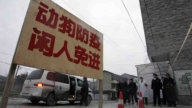【新唐人2011年3月14日讯】中共最新数据显示,中国的债务仅占中国国内生产总值(GDP)17%,学者表示,中共当局公布的债务远远低于实际数字,如果把地方政府和国有银行的负债计算在内,中国的债务负担恐怕是目前数据的四倍以上。
根据中共财政部的报告,2010年底中央政府的债务是1.03万亿美元。这相当于占中国国内生产总值(GDP)17%左右,远远低于美国、日本和欧洲主要国家他们的债务占GDP的比重。
但这个数据并不包括很多大型国企、地方政府、甚至中央部委所持有的债务。渣打中国经济学家王志浩估计,如果把不确定是否发生的或有负债计算在内,负债比达77%。这个数据是中共官方公布数据的4倍还多。
美国《当代中国研究》杂志主编程晓农表示,中共当局公布的中央政府债务远远低于实际数字。
程晓农:“中共到2010年中央和地方政府的债务总额大概是超过15万亿,是财政收入的百分之一百八十三,这个数字实际上是远远低估的,根据中共已经在2009年前所作的初步的调查,地方政府欠的债当中,65%是地方政府必须直接偿还的,12%是地方政府担保的,就是说他负有担保责任,还有24%是属于政府兜底的, 实际上不论是地方政府直接偿还、担保、还是兜底,都说明所有债务其实都是政府债务。”
除中共官方公布的债务,据相关数据,截至2010年底,由国家开发银行和其他政策性银行发行的债券中,“未偿还的债务”总额达到7,850亿美元。
程晓农指出,目前中国还有一种”地方融资平台”,透过地方政府凭空虚构一家公司,代表地方政府向银行贷款或者发行债券,目地是隐瞒政府债务。
程晓农:“因为中国的地方政府是不允许直接借债的, 到现在为止中共的预算法还没有修改, 地方政府现在不能借债, 而地方政府又欠十几万亿的债, 他的偿还责任自然就是中共中央政府的财政部 , 所以财政部为了减少自己的责任, 他现在宣称这些债务的大部分不属于政府债, 而是公司债, 也就是说他在玩弄概念游戏。”
由于地方政府债务的隐蔽性,具体数据没有公布,但中共已经启动审计。业内保守估计,2010年地方债总额超过1.52万亿美元,债务率超过150%。
程晓农还表示,中共启动审计的原因就是中共中央现在也不知道到底有多少债务,到最后恐怕还是全民买单:
程晓农:“中共现在实际上是很多地方政府大举借债, 但并没有偿债能力, 很多地方政府要不就是赖账, 要不然就是借新债还旧债, 在目前这种情况下, 如果赖账,就会导致银行借给地方政府的十几万亿变成完全的坏帐, 也就是说老百姓存在银行的十几万亿存款将泡汤 “
数据显示,地方融资平台有54%的贷款期限在五年以上,2011年到2013年是融资平台贷款集中到期的时间,中共财政部财政科学研究所指出,一些地方融资平台负债比高达94%,海南岛部分地区融资比甚至达300%,大大高于80∼120%的国际风险警戒线。分析人士认为,缺乏透明度与法令规范都会让地方政府债务风险在未来两、三年爆发。
新唐人记者林平、王明宇采访报导。
China’s Debt Underestimated
Latest official data shows China’s debt to be 17%
of GDP. Some scholars say the officially announced
debt figure is far below the actual debt figure.
Combing the liabilities of local governments and
state-owned banks, China’s debt burden should be
more than four times than the current figure.
According to the Chinese Ministry of Finance’s
report, in Dec 2010, the central government’s debt
was USD 1.03 trillion, equivalent to 17% of China’s
GDP. It is much lower than the ratio of debt to GDP
in the U.S., Japan and major European countries.
However, this figure doesn’t include the liabilities
of many large state-owned firms, local governments
and many central government ministries.
Standard Chartered economist Stephen Green
estimates that by accounting for contingent liabilities,
the debt ratio would reach 77%,
4 times China’s officially released figure.
The U.S.-based magazine Modern China Studies’
editor-in-chief, Cheng Xiaonong, said that theofficial debt figure announced by the central
government is far below the actual figure.
Cheng: In 2010, the combined debt of
the central and local governments was over
$15 trillion, which was 183% of the fiscal revenue.
This figure is actually quite underestimated.
According to an official preliminary investigation
prior to 2009, 65% of the local governments debts
must be repaid directly by the local governments,
12% was guaranteed by the local governments,
and 24% would be undertaken by the government.
Regardless of the form,
all debts are government debts.
In addition to China’s officially announced debts,
as of the end of 2010, out of the bonds issued by
China Development Bank and other policy banks,
the “outstanding debt" amounted to USD 785 billion.
Cheng said, “local financing platforms" exist in China.
These are shell companies that borrow bank loans
or issue bonds on behalf of their local governments,
for the purpose of hiding government debts.
Cheng: Chinese local governments are not allowed
to borrow directly. As China’s current budget law is
still in effect, and local governments have
dozens of trillions of debts, the debt repayment
obligation falls on the Finance Ministry.
In order to reduce its own liabilities, the Ministry now
claims most of these debts to be corporate debts.
That is, they are playing concept games.
Due to the invisibility of local governments’ hidden
debts, the specific data is not disclosed,
but the central authorities have started an audit.
A conservative estimate of total debts raised in 2010
is over USD 1.52 trillion,
exceeding a debt ratio of 150%.
Cheng said, the audit is being carried out, because
CCP’s Central Committee doesn’t know
the real figure. It’s quite possible that
the people will pay the bills.
Cheng: Many local governments raise huge debts,
but they are insolvent. Many local governments bilk.
Others repay old loans by incurring new debts.
Under these circumstances, if the governments bilk,
all of their bank loans will turn completely bad.
That means, over a dozen trillion USDs worth of
people’s deposits in the banks will evaporate.
Statistics show that 54% of the loan terms
by local financing platforms are over 5 years.
2011 to 2013 is a period of concentrated due dates
for loans borrowed by financing platforms.
Finance Ministry’s Research Institute of
Fiscal Science pointed out that some local
financing platforms have debt ratios of up to 94%;
some areas on Hainan Island even reached 300%,
exceeding the 80-120% international risk warning
level. Analysts believe that the lack of transparency
and legal regulations will allow the local
governments’ debt crisis to break out in the next
2 to 3 years.
NTD reporter Lin Ping and Wang Mingyu






























